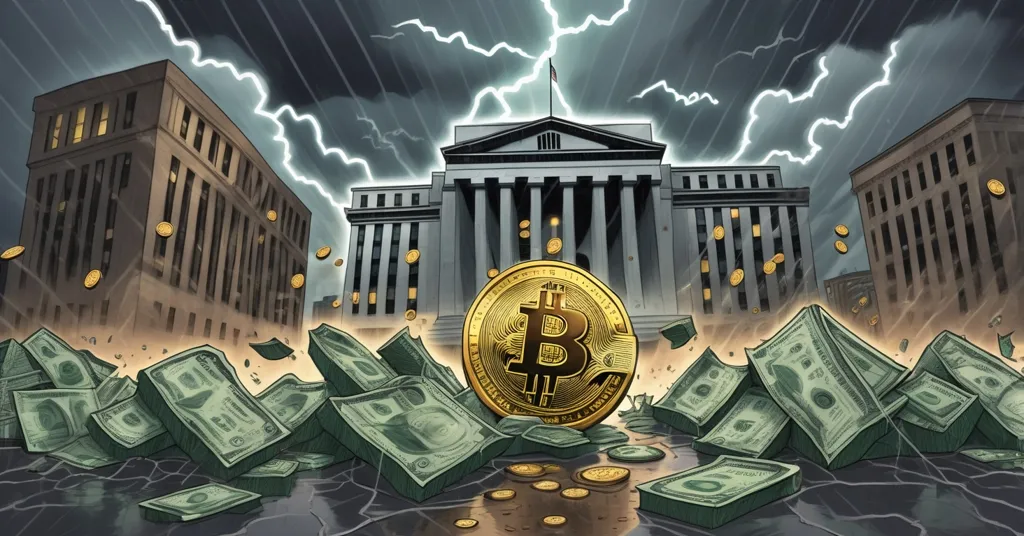Funding Fears Hit Markets: Fed Futures Surge Shakes Bitcoin and Crypto Ahead of Quarter-End

Funding Fears Shake Markets: How Fed Futures Surge Impacts Bitcoin and Crypto Ahead of Quarter-End
A perfect storm is hitting U.S. funding markets as the financial quarter nears its close, with traders scrambling into federal funds futures at unprecedented levels to shield against a looming short-term cash crunch. This frenzy, driven by spiking overnight borrowing costs and dwindling bank reserves, puts the Federal Reserve’s high-wire act under a harsh spotlight—while Bitcoin and the broader crypto space brace for the ripple effects.
- Unprecedented Frenzy: Nearly 500,000 September fed funds futures contracts traded in a single day, shattering past records.
- Market Strain: Fed funds rate hits 4.09%, repo rates climb, and liquidity tightens across the board.
- Crypto at Risk: Funding stress could drag Bitcoin and altcoins down short-term, but also spotlight decentralization’s appeal.
Funding Market Chaos: What’s Unfolding?
The financial world is on edge, and the data paints a grim picture. On a hectic Wednesday in New York, trading volume for September federal funds futures—contracts tied to the Federal Reserve’s overnight benchmark rate—soared to almost half a million, blowing past a record set in April 2023 amid trade tariff shocks. This isn’t just market chatter; it’s a screaming alarm. The effective fed funds rate, which tracks the real cost of overnight borrowing among banks, ticked up to 4.09% on Monday. One basis point (that’s 0.01%, a tiny but telling shift in finance) outside the Fed’s target range is enough to spook traders and fuel this futures binge.
Driving this panic is the repo market, the unsung backbone of daily finance where banks and firms borrow cash for a mere 24 hours, usually putting up Treasuries as collateral. Think of it as a quick handshake loan between financial giants—when it works, no one notices; when it doesn’t, chaos ensues. Right now, it’s not working smoothly. Repo rates are surging due to a brutal mix of factors: the U.S. Treasury issuing more bills to refill its coffers, bank reserves at the Fed shrinking to $3.15 trillion, and the Fed’s ongoing quantitative tightening (QT) policy, kicked off in June 2022, which pulls liquidity out of the system by shrinking its massive balance sheet. The gap between repo rates and the fed funds rate has widened to 11.5 basis points, up from under 10 in July and August, and the biggest spread since April. That’s a glaring red flag for stress in overnight borrowing costs, as traders rush to hedge against funding fears.
For those new to this game, overnight borrowing is how banks cover short-term gaps—think of it as borrowing lunch money until payday, except the stakes are billions. When rates spike like this, it signals either a cash shortage or crumbling trust. Historically, repo market seizures, like the infamous 2019 crisis, have forced emergency Fed interventions. Back then, overnight rates skyrocketed, exposing how fragile the system can be at quarter-end when firms tidy up balance sheets. With September’s close looming, history might just rhyme again.
Breaking It Down: What Are Repo Markets and Fed Funds?
Let’s strip this to basics. The federal funds rate is the interest rate at which banks lend to each other overnight without collateral—it’s the Fed’s main lever for steering the economy. Futures tied to this rate let traders bet on where it’s headed, a hedge against surprises. The repo market, short for repurchase agreement, is where firms borrow cash for a day or two by pledging safe assets like Treasuries as a guarantee. It’s the oil in the financial engine, ensuring cash flows where it’s needed. When repo rates jump above the fed funds rate, as they’re doing now, it means borrowing is getting pricier and harder—often a prelude to broader market hiccups. Why care as a crypto fan? Because these hiccups in traditional finance (TradFi) often spill over, shaking investor confidence in riskier assets like Bitcoin or altcoins.
The Fed’s Tightrope: Tools and Risks
Bank reserves, the cash buffers banks stash at the Federal Reserve, are central to this mess. They’ve dropped to $3.15 trillion, not yet critical but on a worrying slide. Fed Governor Christopher Waller has flagged $2.7 trillion as the bare minimum for “ample” reserves to keep markets stable. Meanwhile, the Fed’s overnight reverse repo tool—a parking lot for excess cash from money market funds—has seen usage collapse to a four-year low, a sign that the post-2008 era of cheap, endless liquidity is over.
“We are seeing a level shift in funding. Money funds no longer have excess cash to deploy to the RRP,” noted Mark Cabana from Bank of America.
Cabana’s point hits hard. With less spare cash floating around, the cost of borrowing overnight is creeping up, and the tension is thick. The Fed isn’t sitting idle, though. Its Standing Repo Facility (SRF), rolled out to avoid repeat disasters like 2019, lets eligible firms borrow cash against Treasuries at a fixed rate, acting as a pressure valve. Usage peaked in June since it went permanent in 2021, but here’s the rub: it’s like a shiny new fire extinguisher—looks promising, but will it work when the flames are real? Critics point out that the SRF’s strict eligibility rules might exclude key players in a true crisis, leaving gaps in the safety net. Analysts at JPMorgan argue it could still cap repo rate spikes, but I’m not betting the farm on the Fed’s quick fixes.
More headaches loom next week with corporate tax payments and fresh Treasury auctions, both poised to suck more cash and collateral out of the system. Quarter-end always brings volatility as institutions scramble to look pretty on paper, and the Fed’s commitment to QT—despite murmurs of concern from Dallas Fed President Lorie Logan—shows no sign of wavering yet. Fed official Roberto Perli, who manages the securities portfolio, keeps hammering the importance of short-term rate tools to handle these bumps, but if a full-blown crunch hits, tweaking dials might be like rearranging deck chairs on the Titanic.
Lessons from 2019: A Warning for Today
Cast your mind back to September 2019, when the repo market imploded overnight. Rates spiked to 10% as cash vanished, forcing the Fed to pump billions into the system to restore order. It was a glaring wake-up call about how fast things can unravel when liquidity dries up. Bitcoin took a hit initially, dropping around 10% as risk-off panic gripped markets, but within months, it rallied as distrust in centralized finance grew. That pattern—short-term pain, long-term gain for BTC—could play out again if today’s funding fears escalate. The difference now? The Fed’s balance sheet is still shrinking under QT, and reserves are tighter than they were pre-2019. If history is a guide, we’re skating on thin ice.
Crypto in the Crosshairs: Opportunity or Threat?
So, what does this TradFi drama mean for Bitcoin and the crypto ecosystem? Let’s not mince words: in the short term, funding squeezes and a risk-off mood could bloody the market. When liquidity tightens in traditional systems, investors often ditch speculative assets like BTC and altcoins faster than a hot potato. Bitcoin’s correlation with equities during past tightening cycles, often hovering around 0.6 to 0.8 on a 90-day basis, suggests it’s not immune to broader market fear. If the Fed fumbles this, the fallout won’t spare crypto, no matter how much we chant “decentralization.”
But flip the coin, and there’s a silver lining—hell, maybe a gold one for Bitcoin maximalists like myself. When centralized systems creak under their own weight, BTC’s case as a trustless hedge gets louder. If faith in the Fed’s ability to manage liquidity erodes, some investors might park cash in Bitcoin as a middle finger to fiat fragility. Look at past crises: post-2019, BTC climbed over 300% in two years as quantitative easing sparked inflation fears. Systemic stress today could ignite similar interest, especially among those burned by TradFi’s promises.
That said, let’s play devil’s advocate. Bitcoin isn’t universally seen as a safe haven—many still treat it as a speculative gamble. During sharp market crashes, like March 2020, BTC tanked 50% alongside stocks before recovering. If funding fears trigger a broader sell-off, don’t expect all hands to rush to Bitcoin lifeboats. Retail investors, especially, might just cash out and wait for calmer waters.
Altcoins and decentralized finance (DeFi) bring their own flavor to this mess. While Bitcoin might stand as a store of value, leveraged tokens and meme coins could get obliterated in a risk-averse climate—think Dogecoin or Shiba Inu taking a 30-50% haircut if panic sets in. Yet, DeFi protocols like Aave or Compound, built on Ethereum’s smart contracts, could shine as alternatives to repo markets. Need short-term liquidity? Skip the banks and borrow via a blockchain-based lending pool, no middleman required. Of course, DeFi isn’t bulletproof—smart contract bugs and liquidation cascades during volatility could amplify losses. It’s a double-edged sword, but damn if it doesn’t showcase blockchain’s disruptive grit.
Accelerating the Inevitable: TradFi’s Stumble as Crypto’s Gain
From an effective accelerationism (e/acc) lens, this funding fiasco is a feature, not a bug. Every stumble by centralized finance—every rate spike, every untested tool—pushes us closer to a world where decentralized systems aren’t just nice-to-haves but necessities. Sure, Bitcoin and crypto might bleed in the near term if markets tank, but long-term, TradFi’s failures are the rocket fuel for adoption. The Fed playing with fire isn’t just a risk; it’s a catalyst. If they botch this, the case for a trustless, borderless money like BTC only gets stronger. Ethereum’s DeFi ecosystem, Solana’s speed, or even niche chains filling gaps—each plays a role in chiseling away at the old guard’s monopoly. Disruption doesn’t come without pain, but I’ll take the growing pains over stagnation any day.
Key Questions and Takeaways on Funding Fears and Crypto Impact
- What’s fueling the massive surge in fed funds futures trading?
Traders are hedging against a potential cash shortage at quarter-end, rattled by a fed funds rate creeping to 4.09% and repo borrowing costs signaling severe liquidity strain. - Why are repo markets buckling under pressure right now?
A vicious combo of Treasury bill issuance, bank reserves dropping to $3.15 trillion, and the Fed’s quantitative tightening are driving up overnight borrowing costs, risking a market freeze. - Can the Fed’s safety tools avert a full-blown crisis?
The Standing Repo Facility is meant to prevent repo panics, but its untested nature and limited reach under real stress leave big question marks about its effectiveness. - How might this funding crunch hit Bitcoin and crypto markets?
Tight liquidity and risk-off sentiment could hammer Bitcoin and altcoins short-term, but cracks in traditional finance might also drive interest toward decentralized hedges like BTC. - What role could altcoins and DeFi play in a liquidity squeeze?
Bitcoin may stand as a store of value, but altcoins face higher volatility risks, while DeFi platforms like Aave could offer lending alternatives to strained repo markets—though not without hazards. - Will the Fed rethink quantitative tightening anytime soon?
Despite mounting market stress, there’s no solid hint of pausing QT yet, but sustained chaos through September could force policymakers to reconsider their stubborn stance.
Navigating this financial quagmire demands sharp eyes and sharper wits. The Fed’s next moves will ripple far beyond Wall Street, shaping risk sentiment that inevitably touches crypto. For Bitcoin purists, every centralized misstep is another brick in the case for a decentralized future. But let’s not pretend altcoins and other blockchain innovations don’t have skin in the game—Ethereum’s DeFi tools or niche protocols often fill gaps BTC doesn’t touch. As quarter-end looms, the funding fears gripping markets today remind us that shaking up the status quo is messy business, for fiat and crypto alike. Stay vigilant; if the past teaches us anything, surprises lurk just around the corner. And when the dust settles, it’s worth asking: are we ready to bet on Bitcoin, or are we still chained to the old guard’s shaky promises?



